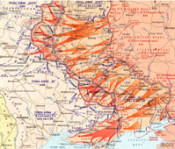
Anniversary of the end of the Battle of the Dnieper during the Great Patriotic War
December 23, 1943 ended the Battle of the Dnieper of the Great Patriotic War.
Battle of the Dnieper was a combination of several operations within the advance of the Soviet army during the Great Patriotic War, and was intended to liberate the left banks of the Dnieper, the lands of Ukraine, the Donbass, crossing the Dnieper River and capture of the strategically important facilities and territories.
By the beginning of the Battle of the Dnieper in the south-western strategic sector the Soviet troops opposed to a strong enemy force including the 2nd Army of the Army Group "Center", the 4th Panzer Army, the 8th, the 1st Panzer Army and the 6th army of the Army Group "South" (Field Marshal General E. Manstein), totally about 1, 250 000 men; 12,.600 guns and mortars, about 2, 100 tanks and assault guns, and up to 2, 000 aircrafts. The Soviet troops included about 2, 650 000 men, more than 51, 000 guns and mortars, more than 2, 400 tanks and self-propelled guns and 2, 850 aircrafts.
The first phase of the battle began on 26 August, when the forces of the Central Front went on the offensive. Most successful were the troops of the 60th Army under General I. D. Chernyakhovsky, which managed to break through the German defenses on the secondary sector, south of Sevsk. Front Commander General K. K. Rokossovsky threw into the breach the main shock troops of the front, which was a major strategic advantage. By August 31, the breakthrough of the enemy’s defense extended to 100 km wide and up to 70 km in depth, forcing the Germans to begin the withdrawal of troops to the Desna and the Dnieper. Meanwhile, joined forces of the Voronezh and Steppe Fronts joined the offensive.
August 13-16, began the advance of South Western front, and August 18 the offensive was joined by the Southern Front, breaking the defensive line on the River Mius, and liberating Taganrog August 30. In early September, the offensive of the Red Army unfolded across the Left-Bank Ukraine and in the Donbass. In these circumstances, the German command began to withdraw its troops to other side of the Dnieper. In pursuit of the retreating enemy, the advance units of the Red Army reached the Dnieper at the 750-kilometer stretch from Loev to Zaporozhye and immediately began crossing the river. By the end of September Soviet troops occupied 20 bridgeheads on the right bank. German government plans for the long defense of the Left Bank were disrupted.
In the second phase of the battle, in October - December 1943, a stubborn fight for places of arms began. Meanwhile, the reserves were being pulled up; bridges were being built and strength for another blow was being developed.
From 26 September to 20 December was held the Nizhnedneprovsk operation by the armies of the Steppe (2nd Ukrainian), South-Western (3rd Ukrainian) and Southern (4th Ukrainian) Fronts. As a result of the operation was released the North Tavria, blocked the Crimean Peninsula and captured the largest bridgehead on the right bank of the Dnieper, from Cherkassy to Zaporozhye. Nizhnedneprovsk operation was notable for fierce battles and heavy losses on both sides.
In November, the center of all events on the Dnieper moved to the Kiev sector, which was crucial in the battle for the Right Bank Ukraine. November 6 the capital of Ukraine, Kiev, was liberated from the enemy troops by the 1st Ukrainian Front. After the operation to free Kiev, battle lines and communication units of the 1st Ukrainian Front, commanded by Army General N. F. Vatutin were stretched for many kilometers.
German troops took advantage of the fact, making a number of counterattacks to restore the defensive line along the Dnieper. From the very beginning of the operation the nature of the fights was quite fierce. Despite the stubborn resistance of the Soviet troops and heavy losses in men and material, the enemy command, having received large reinforcements, managed to break the defense of the Red Army at several areas and encircle a part of the forces of the 60th Army. November 20, Germans recaptured Zhitomir, liberated a week before.
Continuous enemy counterattacks continued until the end of November. By 30 November the Soviet command succeeded to stabilize the front line. In December, the German 4th Panzer Army twice tried to break through to Kiev. December 7-14, three armored divisions of the enemy, including the 1st Panzer SS Division "Leibstandarte Adolf Hitler", attacked the town of Radomyshl, and 16-20 December made another blow near the village of Meleni. December 21-22, after heavy and exhausting fightings, Soviet forces passed to the counteroffensive and threw back the enemy forces. German plan to break through to the Dnieper River and capture Kiev was frustrated. The Kiev defense operation ended with the termination of the Battle of the Dnieper.
During the Battle of the Dnieper, Soviet troops inflicted a heavy defeat on the main forces of the Army Group "South" and on a part of the Army Group "Center" of the enemy; liberated more than 38, 000 villages, 160 cities and towns. The capture of bridgeheads on the Dnieper provided the necessary conditions for the offensive in Belarus, the complete liberation of the Right-Bank Ukraine and the development of a successful attack in the western and south-western sectors.
Soldiers, sergeants, officers and generals of all the armed forces who had particularly distinguished themselves in battles, were awarded the title of the Hero of the Soviet Union. Many units and formations were given honorary title of "Kiev", "Dnepr", "Poltava", "Chernigov", "Dnepropetrovsk", "Zhitomir", "Fastov", "Kremenchug," "Mariupol", "Melitopol" etc.
Lit.: Гречко А. А. Освобождение Киева. М., 1972; Смотрицкий Е. А. Битва за Днепр. М., 1983; Тельпуховский Б. С. Битва за Днепр и освобождение Киева. М., 1966; Уткин Г. М. Штурм Восточного вала. М., 1967.
Based on the Presidential Library’s materials:

